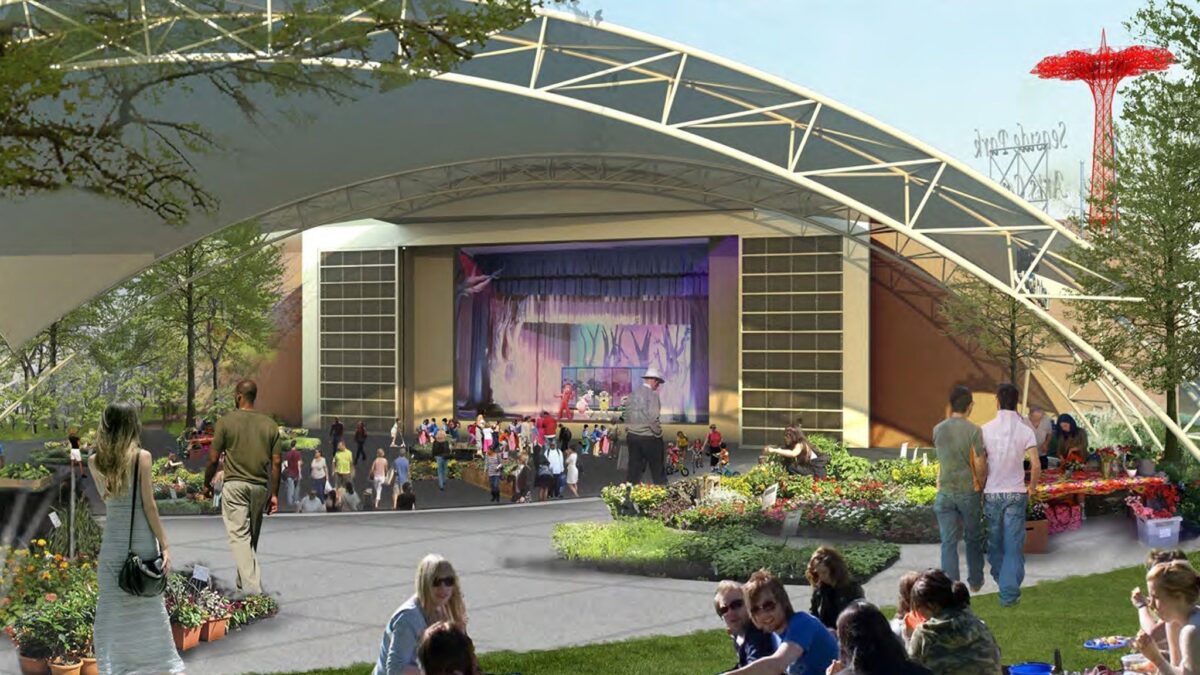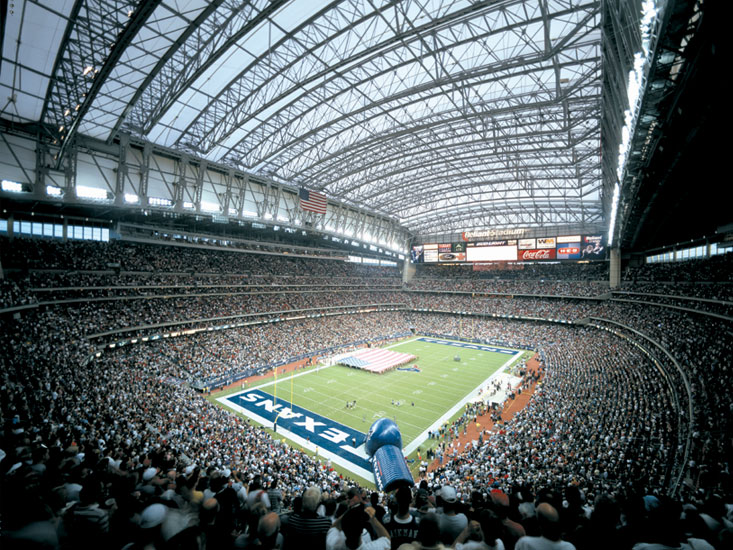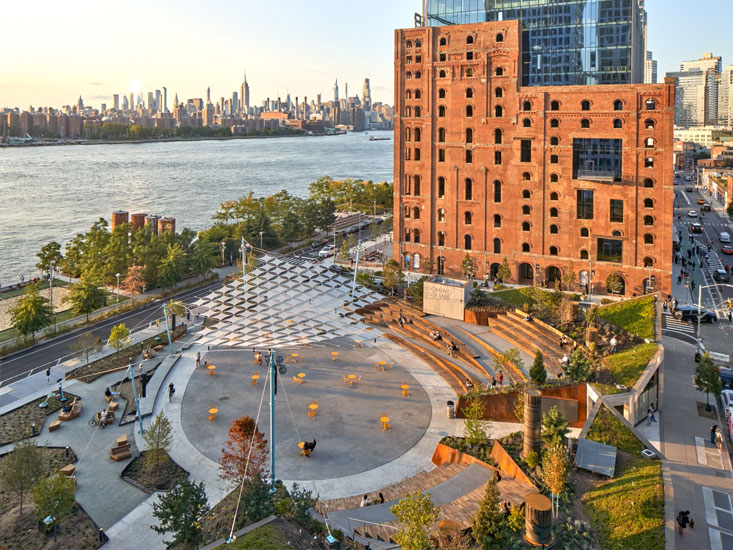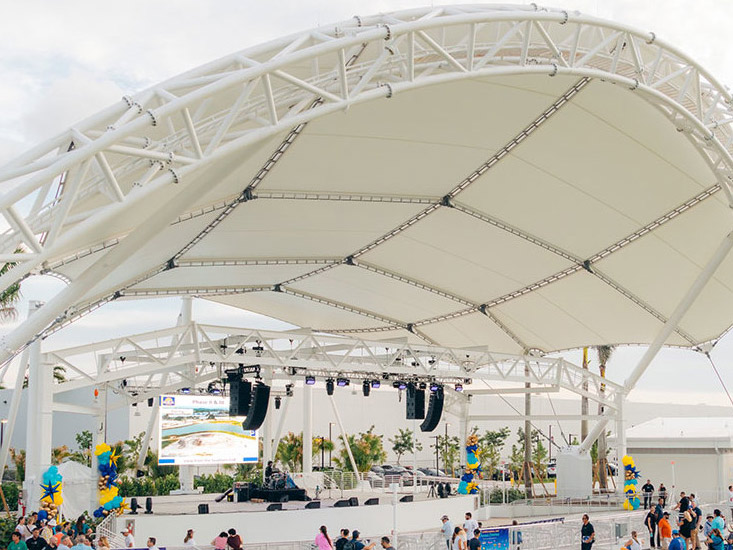

Adaptive Reuse Spawns Coney Island’s Ford Amphitheater, an Iconic Urban Venue Topped with Birdair PVC Membrane
The new venue—covered by a canopy featuring a PVC polyester membrane exterior and liner from Birdair—was built out from the dilapidated structure of the historic Childs Restaurant, which last flourished in the early-mid 20th century.
Published: October 04, 2016
Birdair, Inc. is pleased to announce the completion of the new Ford Amphitheater in Coney Island, Brooklyn, NY. The new 5,000-seat entertainment venue is part of New York City’s Seaside Park and Community Arts Center—a new community development that aims to bring a mix of year-round entertainment, new businesses and publicly accessible open space along the western portion of Coney Island’s famous Riegelmann Boardwalk.
The new venue—covered by a canopy featuring a PVC polyester membrane exterior and liner from Birdair—was built out from the dilapidated structure of the historic Childs Restaurant, which last flourished in the early-mid 20th century. The restaurant space itself has been renovated and converted into a backstage, VIP and restaurant areas for the concert facility.
The $53 million project was completed in June 2016 thanks to a collaborative effort between FTL Design & Engineering Studio (as the tensile roofing consultant), GKV Architects (for the Childs Restaurant restoration and Seaside Park development), Birdair (design and fabric installation), structural engineering firm WSP USA, Mueser Rutledge Consulting Engineers (for geo-tech engineering) and general contractor Hunter Roberts Construction Group.
An Icon of Revitalization
Over the past century, the Childs Restaurant site has undergone various stages of vibrancy and disrepair. During the 1930s and 1940s, it was a thriving recreational destination for both tourists and locals. However, by the 1960s and 1970s, it had become run-down and its nearby piers sat empty. Now, the new Ford Amphitheater—constructed to withstand flooding and natural disasters on the heels of 2012’s Hurricane Sandy—is poised to become a catalyst for the area’s rebirth.
“This is a shining example of adaptive reuse of a really wonderful structure,” says Nic Goldsmith, Senior Principal at FTL. “By augmenting an older building with a tensile structure and other enhancements, you get a new destination that brings in energy, money and culture, all at once.”
“We’re proud to have contributed toward a project that merges great engineering with sensible urban design,” says David Capezzuto, Director of Business Development for Birdair North America.
The Acoustics Advantage
In the design of the new amphitheater, FTL overcame numerous challenges throughout the process. The venue needed an iconic look and an open feel, but it couldn’t overpower the historic landscape of Coney Island. In addition, with its location adjacent to a retirement community, creating a structure with exceptional acoustic insulation was essential—as was maintaining a refreshing, open-air experience.
“Birdair, with their expertise and knowledge, came up with a sandwiched system that was able to absorb enough sound to create an acoustically neutral space,” says Goldsmith.
About the Roofing Structure & PVC Membrane
The new roof on the Ford Amphitheater, designed and installed by Birdair, features approximately 40,900 square feet of a PVC membrane exterior and 32,565 square feet of a PVC membrane liner, with two acoustical curtains. These curtains are supported by two pairs of structural steel leaning arches that define smaller scaled fabric fields, allowing for demountable functionality to make the venue hospitable year-round. The structure’s clear span arches also extend for over 100 feet, providing infrastructure support for sound and lighting fixtures and creating uninterrupted sight lines.
“The intricate complexities of the site and its use required a seasonal structure that could be demounted during the off season and stored on site. Fabric solutions offer one of the few possibilities for such a condition and the PVC fabric was especially well suited for this application,” says Goldsmith.PVC membrane is a cost-effective alternative to traditional roofing systems and can be produced in a multitude of colors to coordinate with individual building project needs. When produced in bright white, this flexible fabric membrane reduces radiant heat gain, keeping interior temperatures cooler during warmer weather conditions. Technically, PVC is a molecule comprised of carbon, hydrogen and chlorine. The combination of these elements results in a single-ply membrane that is simple to manufacture. During fabrication, remnants can be recycled and melted down to be reproduced, resulting in less waste.
Because PVC is a thermoplastic, this membrane can be softened into a semi-solid state and infused with UV light inhibitors and anti-soiling fungicides. During installation, multiple sheets of the fabric can be overlapped and fused together in a process known as weldable seam technology. Once cooled at room temperature, these sheets form one continuous membrane.
Lastly, PVC membrane is fire resistant and meets numerous energy code standards, including those set by the U.S. Environmental Protection Agency and the U.S. Department of Energy.
Download PDF Version: BIR_SeasideAmphitheater_Completion 160930.pdf
Coney Island Ford Amphitheater
Location: Coney Island, NY
About Birdair: Birdair, Inc. is the leading specialty contractor of custom tensile structures throughout the world. In addition to pre-construction services such as design assistance, budgeting, construction methodologies and project scheduling, Birdair provides design-build solutions in all aspects of project design, engineering, installation and maintenance. The company offers a selection of architectural fabric membranes, including PTFE fiberglass, ETFE film, PVC and Tensotherm™. Birdair, based in Buffalo, NY, is a member of the Taiyo Kogyo Group, with operations serving North and South America and other international locations. For more information about Birdair, like us on Facebook, call 1-800-622-2246 or visit www.birdair.com.



